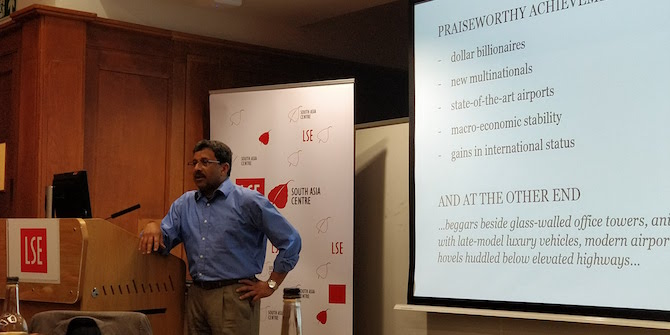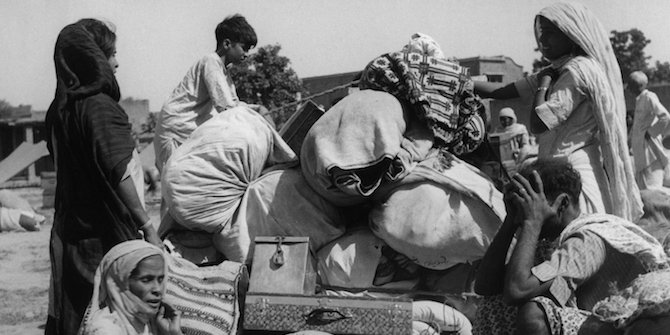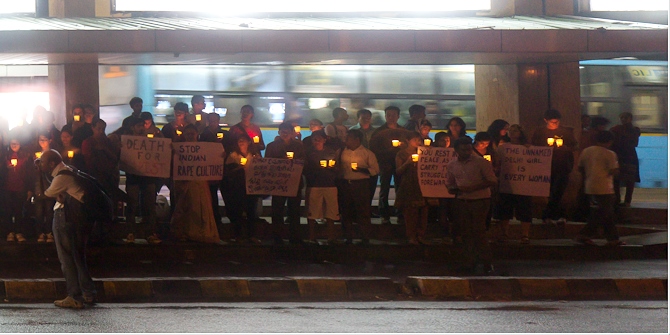As India celebrates its 68th Republic Day, in this photo essay Mahima A. Jain showcases the highlights of LSE South Asia Centre’s exhibition ‘Law and Nationhood: India at 70’ curated by Dr Nilanjan Sarkar and Dr Charlotte de Mille, and the story of the hand-written and illustrated Constitution of India.
In November 2017, snippets from the lives of four figures from India’s freedom struggle, their legal training and their time spent in London were displayed alongside a copy of the hand-written Constitution of India at the LSE Atrium Gallery.
The exhibition commemorated the 70th anniversary of India’s independence focusing on the Constitution of India, and was on display until 7 December 2017. The collaboration between the LSE South Asia Centre, The Courtauld Institute of Art, and The Supreme Court of the United Kingdom Arts Trust, highlighted the shared legal background of MK Gandhi, Jawaharlal Nehru, BR Ambedkar and Krishna Varma, drawing on little-known documents from their respective Inns of Court. The exhibition was jointly curated by Dr Nilanjan Sarkar (LSE) and Dr Charlotte de Mille (Courtauld).
Photos: Mahima A. Jain
A portrait of Dr Ambedkar, London School of Economics’ most famous alumni, from the collection of LSE Arts was the centrepiece. Ambedkar completed his PhD on ‘The Indian Rupee’ at LSE in 1920-21; soon after, he was called to the Bar at The Honourable Society of Gray’s Inn. After gaining his degrees, Ambedkar returned to India. An economist, barrister, jurist, politician and social reformer, Dr Ambedkar is considered to have single-handedly highlighted the plight of India’s lower and ‘untouchable’ castes. He converted to Buddhism in 1956, leading the way to mass conversions of Dalits to Buddhism in India.
Key exhibits in original included admission and call papers of Krishna Varna, Gandhi and Nehru, private correspondence relating to the disbarment of Gandhi and Krishna Varma at Inner Temple, admission letters and documents relating to Nehru and Ambedkar, rare photographs of Gandhi, Jinnah, Nehru, and Patel in the 1930s and 1940s by Kanu Gandhi, and the reinstatement of both Varma and Gandhi by the Inner Temple – including the strong recommendations from Lord Mountbatten for the reinstatement of Gandhi.
Also included in the exhibition were reports from the British national press. The British press, along with news agencies like Reuters, newsreels and television companies like the BBC, provided the first confirmation of the partitioning of the subcontinent, and the birth of independent India here in the United Kingdom. Importantly, Partition — which would have devastating human and political consequences for the region in its immediate aftermath, and continues till today — was widely regarded as a misfortune with the hope expressed that India and Pakistan might re-unite.
According to Dr Sarkar, the exhibition narrates the complex process of transfer of legal and constitutional powers from Britain to India, culminating in the magnificent first edition of the Indian Constitution, which is displayed at the exhibition. It explores at once the complex colonial reaction towards its ‘Barristers’ turning into opponents of their own ‘teachers’, and the contribution that these leaders made to the consolidation of democracy in modern India.
The Process
On 29 August 1947, barely a fortnight after India gained Independence, a Constituent Assembly was established to oversee the writing of the Constitution of India. Dr Ambedkar was elected as the Chairman of its Drafting Committee, and his training as a Barrister and knowledge of legal processes was considered central to his selection as Chairman. He is considered to be the Father of the Indian Constitution, having travelled widely to familiarise himself with parliamentary process, and read all available written constitutions of the world at the time.
The 389 members of the Assembly took 2 years, 11 months and 18 days to finalise its contents: of these, 175 days were spent on compiling the draft, and 114 days on deliberations as they debated, discussed and finally admitted 2,473 amendments out of a total of 7,635 that were tabled.
Co-curator Dr Sarkar said, “The strength of India’s democracy continues to be embedded in institutions, rules and regulations established by the founding fathers of the nation: the Constitution stands at the heart of it, being the bedrock of India’s proud traditions of secularism, and equality before law. Whenever contrarian forces have challenged these pillars of India’s identity, the Supreme Court has upheld the virtues enshrined in law for all Indian citizens.”
Constitution as Work of Art
Source: The World Digital Library
The original Constitution of India was hand-written, and is 16 x 2 inches weighing 3.75 kg. It is kept in a special helium-filled case in the library of the Parliament of India. Copies of the Constitution were prepared by photolithograph at the offices of the Survey of India in Dehradun. Soon after the Constitution was adopted in 1950, one of the first set of photolithographs was sent to the High Commission of India in London, and was on display at the exhibition. The current Constitution of India is much thicker because of the several amendments included in it since 1950.
Prem Bihari Narain Raizada (Saxena), a famous calligrapher, wrote the complete Constitution in italics; it took him six months and 256 calligraphers’ nibs (no. 303) to complete the work. He did not accept any remuneration for his work but laid the condition that his name would appear on the margin of each page as ‘Prem’, and that of his and his grandfather’s on the last page. The artwork, done by Nandalal Bose and the artists at Shantiniketan, reflects India’s history and diversity. The Constitution is available online.
This article gives the views of the authors, and not the position of the South Asia @ LSE blog, nor of the London School of Economics. Please read our comments policy before posting.
About The Authors
This article is compiled by Mahima A. Jain, Editor of South Asia @ LSE, based on the exhibition ‘Law and Nationhood: India at 70’ curated by Dr Nilanjan Sarkar, Deputy Director of LSE South Asia Centre and Dr Charlotte de Mille of Courtauld.








1 Comments